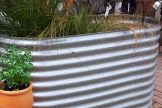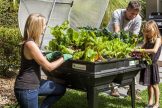
Waring or wombat season is upon us. Mornings are misty and nights are longer. Wombats emerge from their burrows and eagles (Bunjil) are building their nests. Possums are mating and male lyrebirds are showing off their mounds with beautiful song. Autumn rains bring up the fungi in all their colourful glory.
Hopefully the heat of summer has dissipated and soaking rains are on their way. Once they arrive, we have the perfect conditions for growing plants. Autumn is a great time to plant new plants as they will have lots of time to establish before the next summer. While the exotic perennials are showing signs of decline, the Aussie natives, which have been hibernating all summer, kick back into action following autumn rains. Correas are flowering furiously with their long, slender blooms, attracting – if you are lucky, Australia’s version of the humming bird – the Eastern Spine Bill. Try Correa OMG or Fat Bastard for a spectacular display. Or try the Chef’s hat Correa for that shady, dry site – its lime green flowers resembling a chef’s hat.
April is a great month to re-plant the vegie patch too. If the weather is still warm, check the backs of the brassicas to squash any white cabbage moth eggs, and then use an insect net to exclude the adult moths. Try planting a fingerlime, an Australian native citrus with juices stored in caviar like spheres. April is the height of their fruiting.
There’s plenty to do in the garden in April, so put summer behind you and get cracking!

In Your edible garden
Unless there is absolutely no rain, vegies grown over autumn and winter are usually hardier than the summer crop, and after they are established they may only need the occasional water and liquid feed. April is an ideal time to plant, so don’t leave the beds empty. Your vegie beds can play host now to seedlings of broccoli, cabbage, Asian Greens, leeks, and onions. For an over view look at Vegie Patch Basics. If you want to start your vegie garden, but are still uncertain or feel it is a bit much, we run many classes on all sort of vegie and produce gardening, from bee keeping, through vegie basics to espaliering.
Edibles to plant in Melbourne in April.
Below is a list of edible gardening seeds and seedlings that can be planted in April. Please keep in mind that this list has been developed for Melbourne’s climate. Some of the plants indicated will be either right at the start or the end of their ideal planting season, click the links to the factsheets for more detailed planting information.
 – Seeds – Seeds – Seedlings – Seedlings
|
 – Tubers / Crowns – Tubers / Crowns – Companion Plants – Companion Plants
|
 – Protect from frost – Protect from frost – Prone to Cabbage Butterfly – Prone to Cabbage Butterfly
|
Angelica Artichokes (Jerusalem)  Beetroot   Broad Beans   Broccoli    Broccoletti    Broccolini    Brussels Sprouts   Cabbage    Cardamom Leaf  Carrot   Cauliflower   Celery  Chamomile    Chervil  Chicory   Chives   Coriander   Cress   Curry Plant  Dill   Echinacea   
|
Endive Feverfew   Garlic – cloves Good Bug Mix   Green Manure  Kale    Kohlrabi   Leeks   Lemon Balm  Lettuce   Licorice Herb  Lovage  Marjoram  Mint  Mitzuna   Mustard Green   Onion   Oregano  Pak Choy / Bok Choy   Parsley   Parsnip  Peas  
|
Radicchio  Radish   Rocket / Arugula   Saffron Crocus  Sage   Salad Burnett   Salsify  Savory   Shallot   Silverbeet   Snow Peas   Sorrel   Spinach   Spring Onion   Swede   Tarragon   Tatsoi   Turnip   Warrigal Greens  Witloof   Wasabi  Watercress  
|
Autumn, as in spring, is the ideal time to fertilise your garden. Many plants, especially evergreens, put on most of their root growth in autumn. Warm soil and mild conditions with rain lead to a refreshing burst of growth on most evergreen plants. It is a time when soil nutrient levels make a big difference to your plants. Soil improvement is the best way to ensure that you get the best out of your plants. Feed your soil rather than the plants alone. Improved soil structure leads to healthier, more drought-tolerant and disease-resistant gardens. We have a LOT of information on soils – as it is a bit of a passion for various staff members – check it out at our soil health page We now also stock bentonite for people on sandy soils or people wanting to improve the soil mix they buy in from a landscape yard (as these commonly have no clay component).
April is also a good month to give your Buffalo lawn a feed. Buffalo lawns are growing very strongly at this time of year, and a feed now gives it strength before winter and aids a rapid jump away once spring arrives. Iron chelate is a good addition to your Buffalo lawn fertilising regime, use either now or in spring.
BAAG stocks organic composts, mulches and fertilisers in bulk as well as pre-bagged. Check out our range of bulk soils, composts and soil conditioners here.
Mushrooms
Autumn is a good time for mushrooms too. Given the anxiety around foraging for mushrooms, growing your own gives you certainty about what you are eating, and the satisfaction of fresh produce. There are boxes of mushroom spores available that are easy to grow if you follow the simple instructions. There are a couple of different types available, and kids love watching them grow and harvesting them. Remember to keep the mixture moist and cool at all times.

Bulbs are, by their very nature, extremely drought tolerant and can be planted in containers or straight into the ground. Pack the bulbs close together, without actually touching for a massed effect. Since they will not flower for a few months yet, plant alyssum, pansies, violas or other small seedlings over them for some immediate colour. The bulbs will poke through in time. We have a great range of packaged and loose bulbs in stock at the moment.
General
Lift Gladiolus, Liliums and Dahlias after they have finished blooming and the foliage has yellowed off.
Citrus trees need feeding at least twice a year. Leafminer has not been bad this year – but if you do find it, simply prune off. See our fact sheet on citrus leafminer for extra information.
Rake up fallen leaves and add them to the compost heap. Layer them through the heap, or shred them with your lawnmower first, rather than adding them all at once, as they will mat together and not break down readily otherwise. A handful of blood and bone or other high nitrogen organic fertiliser will help break them down more quickly. Perhaps keep a garbage bag full of leaves next to your heap to add a handful every now and again.
Prune back perennials that have finished flowering. Pull out old stakes, clean up and store until spring.
Cut back the amount of water supplied to succulents, cacti and tropical and indoor plants as the weather cools down. Excessive moisture and cold temperatures may cause these plants to rot over the winter.
Autumn rains bring out snails and slugs in full force. Lightly sprinkle bait around newly planted seedlings and shrubs where snails and slugs breed, or try a beer trap to lure them in and drown them. Use snail and slug baits that are iron-based, and safer to use with pets and wildlife. Begonias, lilies and other fleshy leaved plants are popular hiding spots.





